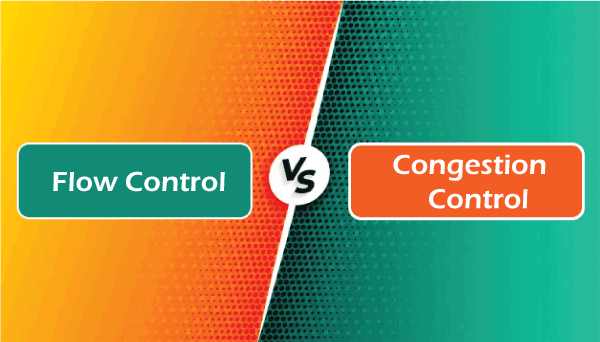Difference between Flow Control and Congestion ControlA computer network is a collection of connected devices that exchange data and resources, and a single network contains many devices. Generally, it is critical to control and manage network congestion and flow to ensure good network functionality. Flow control and congestion control are both traffic control systems, but they operate in distinct ways. The key contrast between flow control and congestion control is that flow control is a system that controls and manages traffic between sender and receiver. In contrast, the congestion control mechanism regulates the traffic placed into the network by the transport layer. In this article, you will learn about the difference between Flow control and Congestion control. But before discussing the differences, you must know about Flow control and Congestion control. What is Flow Control?The process of regulating the data transmission rate between two nodes is known as flow control. If the sender is quick, the receiver may be unable to get and process the data. It may happen due to a high traffic load and a low process power in the receiver. Flow control may help to avoid this type of situation. It enables the sender to control and manage the transmission speed while preventing data overflow from the transmitting node. Similarly, this method allows a sender to send data quicker than the receiver while also receiving and processing data. Types of Flow controlThere are mainly two types of flow control. These are as follows: 1. Feedback-based control When the receiver gets the first frame in feedback-based control, it alerts the sender, enables it to send more data, and informs the sender about the receiver's status. There are mainly two feedback-based flow control protocols: sliding window and stop-and-wait protocol. 2. Rate-based flow control In rate-based flow control, if a sender sends data to a receiver at a quicker rate than the receiver is capable of receiving it, the protocol's built-in mechanism will restrict the sender's data transmission rate without receiving any feedback from the receiver. What is Congestion Control?Congestion may happen because of the availability of many packets in the network. The network performance is decreased by congestion. As a result, the packet delivery to the receiver is delayed, and there may even be packet loss. Congestion control is the responsibility of the transport and the network layer. The transport layer's packet transmissions into the network cause congestion. Congestion on the network may be significantly decreased by minimizing the load on the network by the transport layer. Congestion control may be accomplished via three methods: traffic-aware routing, provisioning, and admission control. Provisioning In the provisioning method, the network may manage and control the traffic. Traffic-aware routing In this method, the routers work according to the traffic pattern. Admission Control The network becomes congested as a result of admission control rejecting new connections. Main Differences between the Flow Control and Congestion Control
Here, you will learn the main differences between Flow Control and Congestion Control. Some main differences between Flow Control and Congestion Control are as follows:
Head-to-head comparison between Flow Control and Congestion ControlHere, you will learn the head-to-head comparisons between Flow Control and Congestion Control. The main differences between Flow Control and Congestion Control are as follows:
ConclusionIn conclusion, congestion control and flow control are two techniques for controlling network functionality. The key distinction between these controlling network functionalities is that congestion control blocks all network traffic. In contrast, flow control restricts high-rate packet transmission from a sender to a receiver.
Next TopicDifference between
|
 For Videos Join Our Youtube Channel: Join Now
For Videos Join Our Youtube Channel: Join Now
Feedback
- Send your Feedback to [email protected]
Help Others, Please Share










